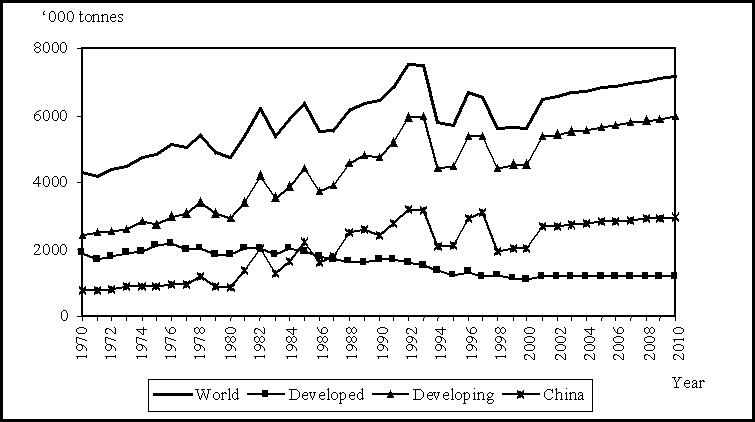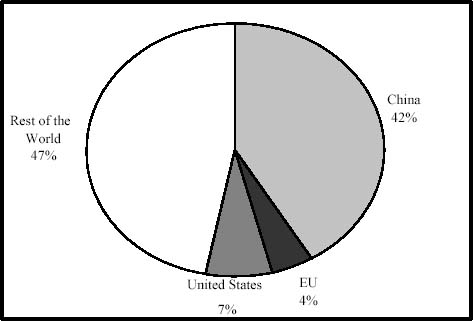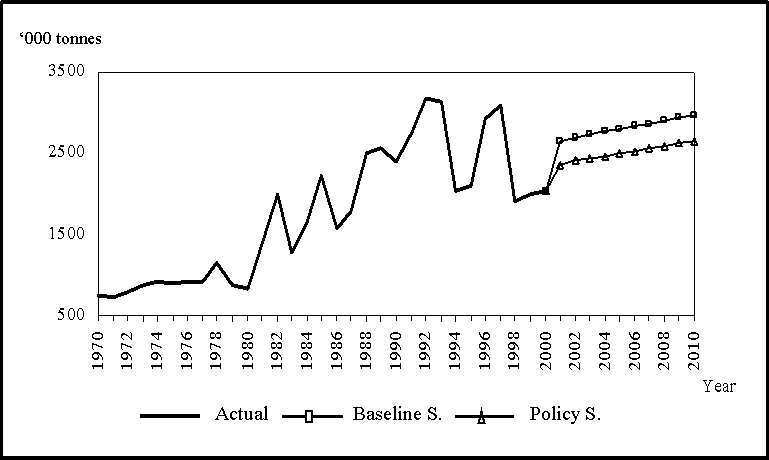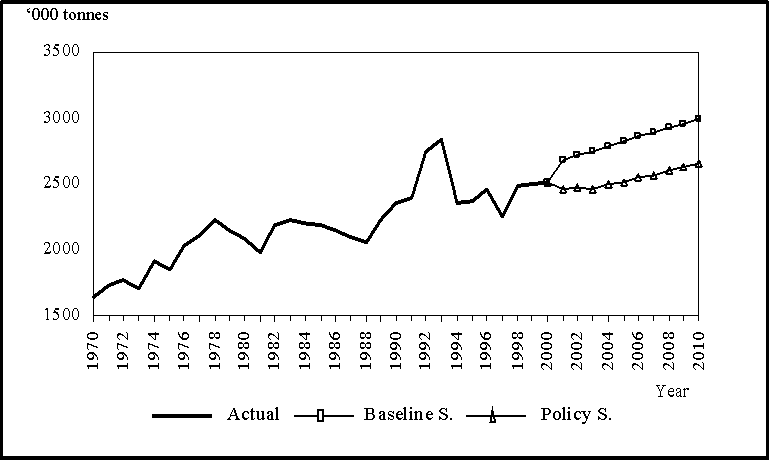About 100 countries produce tobacco, but the major producers are China, India, Brazil, the United States, Turkey, Zimbabwe and Malawi, which together produce over 80 percent of the worlds' tobacco. China alone accounts for over 35 percent of world production, and thus variability of production in China directly affects variability of production figures at world level.
“Production” is the product of area harvested and yield. The methodology for projecting area harvested and yield for each country of the standard country list is given in Annex B.
Tobacco leaf production is projected to reach 7.1 million tonnes in 2010, about 20 percent more than in 1998 in the baseline scenario and 6.4 million tonnes or only 7 percent more than in 1998 in the policy scenario. However, again, this overall pattern conceals two strongly divergent trends. In developed countries, production is expected to continue declining, and to be lower in 2010 than in 1998. On the other hand, in developing countries, production is expected to increase to about 5.9 million tonnes in dry weight in 2010 in the baseline scenario or about 5 million tonnes in the policy scenario. Much of this increase is expected to take place in China, but production is also expected to expand in India, Brazil, Zimbabwe and Malawi.
World tobacco production is projected to reach over 7.1 million tonnes in 2010 in the baseline scenario and over 6.6 million tonnes in the policy scenario, or about 7.5 percent more than in 1998. However, this production level is lower than the record production levels of 1992-1993 (see Figure 3.7).
Figure 3.7 Tobacco leaf - production trends, 1970-2010 (baseline scenario) (dry weight)

The volatility in world production is mainly due to China, which exhibits substantial volatility in the area used for tobacco cultivation (see Figure 3.7). China is expected to account for over 40 percent of world production in 2010 (see Figure 3.8).
Figure 3.8 Tobacco leaf - production share, 2010 (baseline scenario)

After reaching a maximum level of over 1.8 million tonnes in the early 1980s, production of tobacco leaf in the developed countries declined to 1.6 million tonnes in the early 1990s and further to 1.3 million tonnes in 1998. This contraction is expected to continue to about 1.1 million tonnes in 2010 (see Table 3.5) in the baseline scenario.
Table 3.5 Tobacco leaf production - actual and projected
(scenarios - baseline and policy) (dry weight)
| |
Actual |
Projected |
||||||
|
Baseline |
Policy |
|||||||
|
1970-72 |
1980-82 |
1990-92 |
1997-99 |
2005 |
2010 |
2005 |
2010 |
|
| |
' 000 tonnes |
|||||||
|
World |
4 269.4 |
5 455.3 |
6 936.2 |
5 938.3 |
6 809.4 |
7 160.0 |
6 098.1 |
6 430.7 |
|
Developed |
1 797.6 |
1 959.5 |
1 659.0 |
1 178.6 |
1 180.1 |
1 195.7 |
1 081.9 |
1 115.2 |
|
North America |
815.9 |
882.7 |
745.0 |
593.8 |
570.1 |
579.4 |
534.5 |
555.3 |
|
United States |
729.7 |
795.5 |
682.7 |
536.6 |
516.1 |
526.8 |
480.6 |
502.7 |
|
Europe |
544.6 |
648.3 |
602.5 |
418.8 |
460.3 |
467.2 |
418.2 |
435.9 |
|
EU (15) |
248.9 |
320.3 |
397.7 |
278.9 |
297.8 |
300.9 |
258.2 |
272.8 |
|
Other Europe |
295.7 |
328.0 |
204.8 |
139.9 |
162.5 |
166.3 |
160.0 |
163.1 |
|
Area of the former USSR |
249.0 |
258.6 |
55.2 |
85.3 |
69.8 |
70.0 |
61.0 |
61.0 |
|
Oceania |
19.4 |
15.0 |
11.7 |
6.3 |
6.0 |
6.0 |
5.4 |
5.4 |
|
Other developed |
168.7 |
155.0 |
94.4 |
74.4 |
73.9 |
73.1 |
62.8 |
57.6 |
|
Developing |
2 471.8 |
3 495.8 |
5 282.3 |
4 759.6 |
5 629.3 |
5 964.3 |
5 016.1 |
5 315.5 |
|
Africa |
157.7 |
218.8 |
362.0 |
391.3 |
463.0 |
503.3 |
422.5 |
462.5 |
|
Malawi |
23.8 |
49.1 |
109.3 |
102.5 |
125.4 |
137.9 |
114.3 |
132.7 |
|
Zimbabwe |
56.0 |
88.7 |
156.1 |
174.7 |
213.0 |
232.8 |
198.5 |
217.0 |
|
Latin America |
489.7 |
652.8 |
679.3 |
714.4 |
846.2 |
889.0 |
692.7 |
724.4 |
|
Brazil |
225.4 |
357.3 |
430.6 |
450.6 |
545.1 |
584.7 |
421.3 |
450.7 |
|
Near East |
203.7 |
237.8 |
312.8 |
268.3 |
317.3 |
337.3 |
279.2 |
298.0 |
|
Turkey |
151.1 |
181.2 |
261.4 |
210.5 |
250.2 |
268.8 |
218.6 |
237.2 |
|
Far East |
1 620.7 |
2 386.2 |
3 927.9 |
3 385.6 |
4 002.8 |
4 234.7 |
3 621.7 |
3 830.6 |
|
China |
755.2 |
1 413.6 |
2 780.4 |
2 345.6 |
2 806.2 |
2 972.5 |
2 505.1 |
2 653.5 |
|
India |
335.4 |
431.8 |
507.6 |
514.1 |
628.4 |
685.4 |
596.5 |
650.6 |
|
Indonesia |
62.6 |
92.1 |
122.5 |
108.4 |
117.9 |
119.6 |
107.8 |
109.0 |
In developing countries, however, tobacco leaf production continues to increase, thus expanding their share in world production from about 76 percent in 1991 to 87 percent in 2010. China is projected to remain the world's largest producer with 2.6 to 2.9 million tonnes in 2010, well above India with 0.68 million tonnes and Brazil with 0.58 million tonnes. Malawi and Zimbabwe, although major exporters, have much lower production levels and are projected to produce about 0.13 and 0.21 million tonnes respectively.
In the policy scenario, world production of tobacco leaf is projected to be significantly lower, reaching 6.1 million tonnes in 2005 and 6.4 million tonnes in 2010, or about 7.5 percent lower than in the baseline scenario (see Figure 3.9). These projections imply that production in 2010 will remain below the high levels of the 1990s.
Figure 3.9 Tobacco leaf production, world, 1970-2010 (scenarios - baseline and policy) (dry weight)

Yields and area under tobacco production
Tobacco yields (production per hectare) are determined mostly by technological factors and have increased slightly over time with the exception of cases, such as China, where the expansion of production into new, less fertile, areas has reduced average yields. Price effects on yields are much smaller and for all practical purposes can be ignored in an exercise of this kind. Therefore, yields are assumed to increase modestly in the period to 2010 at a rate determined from past trends. Yields are projected to increase in developed countries from 2.2 tonnes/ha in 1998 to 2.3 tonnes/ha in 2010 and in the developing countries from 1.6 tonnes/ha in 1998 to 1.7 tonnes/ha in 2010.
The total area used for tobacco production is projected to change little. A small decline is expected in developed countries and a small increase in developing countries. As shown in Table 3.6, the area under tobacco production in the developed countries is expected to decline slightly from 0.7 million hectares in 1998 to 0.68 million hectares in 2010. On the other hand, in developing countries, the area under tobacco is projected to increase slightly from 4.07 million hectares in 1998 to 4.57 million hectares in 2010 in the baseline scenario and remain at 4.08 million hectares in 2010 in the policy scenario.
Table 3.6 Tobacco leaf area harvested - actual and projected
(scenarios - baseline and policy)
| |
Area |
||||||||
|
Actual |
Projected |
||||||||
|
Baseline |
Policy |
||||||||
|
1970-72 |
1980-82 |
1990-92 |
1997-99 |
2000 |
2005 |
2010 |
2005 |
2010 |
|
| |
million hectares |
||||||||
|
World |
3.80 |
4.18 |
4.99 |
4.77 |
4.17 |
5.09 |
5.26 |
4.56 |
4.72 |
|
Developed |
1.16 |
1.19 |
0.91 |
0.70 |
0.60 |
0.68 |
0.68 |
0.63 |
0.64 |
|
North America |
0.39 |
0.42 |
0.34 |
0.32 |
0.22 |
0.29 |
0.30 |
0.28 |
0.29 |
|
United States |
0.35 |
0.38 |
0.31 |
0.30 |
0.19 |
0.27 |
0.28 |
0.25 |
0.26 |
|
Europe |
0.47 |
0.49 |
0.41 |
0.27 |
0.27 |
0.28 |
0.28 |
0.26 |
0.26 |
|
EU (15) |
0.18 |
0.20 |
0.21 |
0.15 |
0.14 |
0.14 |
0.14 |
0.12 |
0.13 |
|
Other Europe |
0.29 |
0.29 |
0.20 |
0.12 |
0.12 |
0.14 |
0.14 |
0.13 |
0.14 |
|
Area of the former USSR |
0.18 |
0.18 |
0.10 |
0.06 |
0.07 |
0.07 |
0.07 |
0.06 |
0.06 |
|
Oceania |
0.01 |
0.01 |
0.01 |
0.00 |
0.00 |
0.00 |
0.00 |
0.00 |
0.00 |
|
Other developed |
0.11 |
0.09 |
0.05 |
0.04 |
0.04 |
0.04 |
0.04 |
0.03 |
0.03 |
|
Developing |
2.64 |
2.99 |
4.08 |
4.07 |
3.58 |
4.41 |
4.57 |
3.93 |
4.08 |
|
Africa |
0.23 |
0.25 |
0.33 |
0.38 |
0.36 |
0.41 |
0.43 |
0.37 |
0.39 |
|
Malawi |
0.05 |
0.07 |
0.12 |
0.12 |
0.11 |
0.13 |
0.14 |
0.12 |
0.13 |
|
Zimbabwe |
0.05 |
0.05 |
0.07 |
0.10 |
0.09 |
0.10 |
0.11 |
0.10 |
0.10 |
|
Latin America |
0.51 |
0.58 |
0.51 |
0.61 |
0.53 |
0.66 |
0.68 |
0.55 |
0.56 |
|
Brazil |
0.25 |
0.31 |
0.30 |
0.35 |
0.32 |
0.39 |
0.41 |
0.30 |
0.31 |
|
Near East |
0.40 |
0.27 |
0.36 |
0.35 |
0.35 |
0.37 |
0.38 |
0.33 |
0.34 |
|
Turkey |
0.34 |
0.20 |
0.31 |
0.29 |
0.29 |
0.31 |
0.33 |
0.27 |
0.29 |
|
Far East |
1.49 |
1.89 |
2.88 |
2.73 |
2.33 |
2.96 |
3.08 |
2.69 |
2.79 |
|
China |
0.41 |
0.81 |
1.84 |
1.70 |
1.30 |
1.88 |
1.96 |
1.68 |
1.75 |
|
India |
0.45 |
0.44 |
0.42 |
0.45 |
0.46 |
0.50 |
0.53 |
0.48 |
0.50 |
Figure 3.10 Area under tobacco, 1970-2010 (baseline scenario)

The major developed country producers are the United States, the EU, some other countries of Europe (such as Bulgaria) and some countries of the area of the former USSR. Trends in tobacco supply in developed countries in the baseline and the policy scenario are shown in Figure 3.11.
Figure 3.11 Tobacco leaf production, developed countries, 1970-2010 (scenarios - baseline and policy) (dry weight)

In the United States, the signing of the Tobacco Agreement in 1997 opened a new period for tobacco production. The tobacco support programme is in a transitional phase and pressure for its modification or elimination has been gaining momentum over the past decade. As a result, quotas have been reduced while in several states the quota system has been abandoned following referenda held in 2001 (USDA, 2001, p. 16). Production in the United States is expected to continue to decline in the face of weaker demand on both domestic and export markets. Domestic demand for leaf is expected to decline since domestic cigarette consumption in 2001 was projected to be 2 percent lower than 2000 (USDA, 2001, p. 4). Export volumes of both manufactured and unmanufactured tobacco also slipped between 1990 and 2000, indicating a loss of competitiveness in international markets.
In the European Union, the main tobacco producing countries are Italy, Greece and Spain. Production of tobacco leaf increased rapidly in these countries during the 1970s and to some extent in the 1980s, but declined significantly during the 1990s, following mainly the developments in the Common Agricultural Policy. Under the policies in place at present, tobacco production in the EU is expected to continue to decline, while further changes in tobacco support policies may be expected to reduce tobacco production even more.
Production in other European countries and the area of the former USSR is recovering to pre-reform levels. Some of these countries, such as Bulgaria and Bosnia, have been major tobacco producers and exporters in the past but their production contracted severely during the transition period in the 1990s. With the normalization of market conditions, production may be expected to continue to recover in these countries.
Production of tobacco leaf in other developed countries, such as Japan and Australia, is expected to follow the negative trends of the 1990s.
The developing countries account for 80 percent of world production of tobacco leaf and are projected to increase their share to 87 percent in 2010. China remains by far the major producer in the world.
China
In China, production of tobacco leaf has been increasing rapidly, but with wide fluctuations, particularly in the 1990s. Production reached 3 million tonnes in 1991, up from 0.8 million tonnes in 1971 and 1.5 million tonnes in 1981. Since 1993, however, tobacco production has been highly volatile mainly because of volatility in the area used for production.
The government has effective control over tobacco through the Tobacco Monopoly and through planning production, contracting areas, setting prices and controlling marketing, and this is believed to have contributed to the volatility of production in China.
Table 3.7 Area and production on tobacco in China
|
Year |
Area |
Production |
|
|
million hectares |
million tonnes farm weight |
|
1993 |
2.09 |
3.45 |
|
1994 |
1.49 |
2.24 |
|
1995 |
1.47 |
2.31 |
|
1996 |
1.85 |
2.23 |
|
1997 |
2.35 |
4.25 |
|
1998 |
1.36 |
2.36 |
|
1999 |
1.60 |
2.60 |
Figure 3.12 Tobacco leaf production, China, 1970-2010 (scenarios - baseline and policy) (dry weight)

However, the recent decline in production should not be regarded as a trend, since fluctuations in production have resulted in wide fluctuations in stocks which at the beginning of 1999 were standing more than 50 percent above normal levels but have declined significantly since then. Thus, although production in next few years may remain low, it will most probably return to normal trends in the medium term.
Demand for tobacco leaf by cigarette manufacturers in China is declining (by as much as 30 percent) due to the introduction of new processing technologies and new manufacturing equipment in cigarette production. Thus, the pattern of production during the 1990s indicates that in the period to 2010 the growth rates in tobacco leaf production would be substantial, but would remain modest compared to historical rates.
Other developing countries
Among the rest of the developing countries, India is the most significant, producing over half a million tonnes of tobacco leaf in dry weight annually during the 1990s. Brazil, Turkey, Zimbabwe, Malawi are also important producers. Trends in supply from developing countries are presented in Figure 3.13.
In 1998 India grew 0.46 million hectares of tobacco, around 0.25 percent of the total cropped area, and produced about 0.64 million tonnes. Non-cigarette tobacco varieties, such as those used for bidi, account for 75 percent of total production. Production of tobacco has been encouraged by state governments by providing subsidized inputs, price and market support and export promotion. Farmers, also, favour tobacco cultivation as it generally yields higher returns than other crops, although costs are also higher. However, marketing of non-Virginia tobacco has been a problem for farmers, while the introduction of the auction system by the Tobacco Board for Virginia types has fetched better prices for farmers and has led to excess supply of Virginia type tobacco. As a result of the above it seems easier for farmers to reduce production of non-cigarette types (such as bidi) than Virginia types by shifting to other alternative cash crops. Thus, the potential for shifting from tobacco to alternative cash crops appears limited and would be likely to disturb the economic conditions of tobacco-cultivating households.
On the basis of the above observations, under the present policy regime, the area under tobacco is likely to grow only modestly although the area under Virginia and burley tobacco may continue to increase. Yields are expected to accelerate because there is considerable scope for increases in productivity and for cost reduction, thus improving the competitiveness of Indian tobacco (filter type) in the international market. Overall, production of tobacco is expected to maintain a significant growth of about 1.5 to 2.0 percent per annum (Malhotra, 2000).
Figure 3.13 Tobacco leaf production, developing countries, 1970-2010 (scenarios - baseline and policy) (dry weight)

In Latin America the main producers are Brazil and Argentina. In Brazil, strong growth in production in the 1970s (4.7 percent per annum) was followed by lower growth rates (1.9 and 2.7 percent per annum in the 1980s and 1990s respectively). Given that demand in its main trading partners (the United States and Europe) may decline substantially, growth rates in the medium term are expected to moderate. However, there are few alternative crops available to farmers, and also, as the tobacco industry has invested heavily in tobacco production, there is little prospect for tobacco land to be switched to other crops. Overall, a growth rate a little lower than in the past is expected.
Argentina's tobacco production is much smaller then Brazil's but after some decline in the 1980s it now exhibits strong growth. In fact, output growth in the 1990s exceeded expectations, due to the introduction of burley and Virginia types in areas where previously dark tobacco was grown and to the strengthening demand for exports. Given that the country has limited cash crop alternatives, low production costs and several multinational tobacco companies, tobacco production is expected to continue to grow.
Africa's major tobacco producers are Zimbabwe and Malawi. In both countries production expanded rapidly in the 1970s and the 1980s, due mainly to the expansion of the area under tobacco cultivation. The growth rate was higher in Malawi, which started, however, from a lower base. The tobacco industry is well organized in both countries, and is well equipped with technology following recent substantial investments. Although demand by the major trade partners, such as the United States and the EU, is expected to be weaker in the longer term, production is expected to decline in developed countries giving an opportunity for expanding production from Africa. Overall, growth of exports during the period to 2010 is expected to be stronger than that in the base period.
In the Near East the major producer is Turkey, producing almost entirely Oriental tobacco. Turkey ranks fifth in the world in tobacco production after China, India, the United States and Brazil and produces about 4 percent of the world's tobacco. Oriental tobacco which constitutes 97 percent of total Turkish production amounts to less than 10 percent of global tobacco production and it is used for blended cigarettes. Turkey produces about 65 percent of the world's oriental tobacco, the rest being produced by Greece, Bulgaria, Bosnia and countries of the area of the former USSR. Export demand for oriental tobacco is declining, while production of burley and Virginia types is increasing to accommodate the shift in demand. Under the present price support policies, the upward trend in production observed in the 1970s and 1980s was reversed in the 1990s but production is expected to stabilize with growth rates maintained at around present levels.